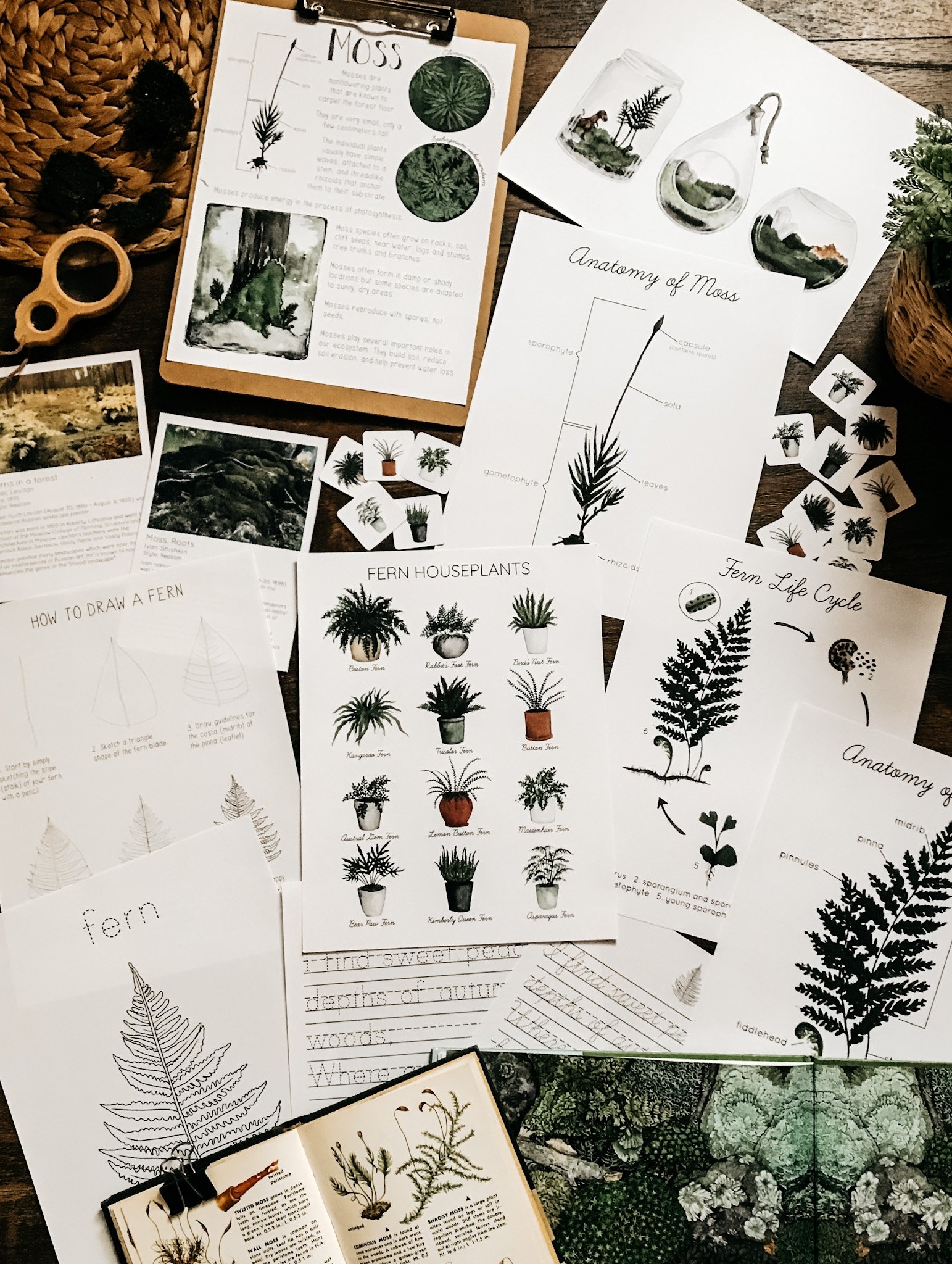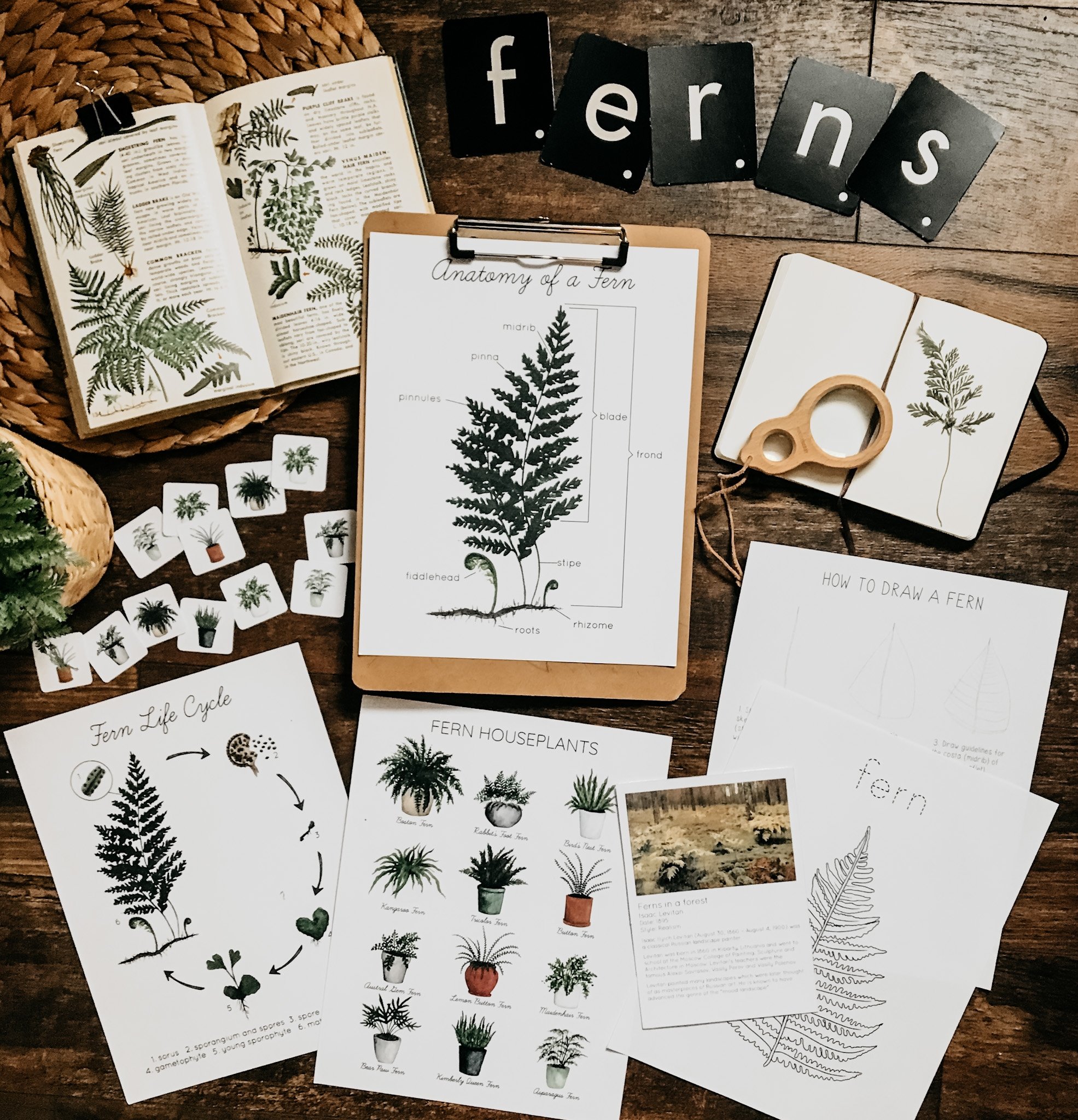Mosses and Ferns Nature Study
Join me as a share everything included my Mosses and Ferns Nature Study!
Mosses and ferns are beautiful plants that play very important roles in our ecosystem. These ancient plants can be found in ecosystems throughout the world. We share a rich history with these plants including some fascinating myths and legends. I hope you’ll enjoy learning about these wonderful plants with us!
UNIT STUDY GOALS
I’ve broken down the study into subjects and under each heading I have made some suggested topics to cover and activities you can do that will cover each of the primary subjects. Our goal is for your students to learn about mosses and ferns by integrating several subjects into our study. This study will explore this topic through many different perspectives such as science, social studies, language arts, math, art and culture. The hope is your students will gain a comprehensive knowledge on the topic by exploring through many methods and activities rather than only reading information from a textbook.
MODIFICATIONS
Unit studies are flexible, and can be adjusted to fit children of various ages and abilities. I do my best to offer suggestions for how you can modify the lessons so each child can study the topic at their own level. Ultimately, you know your children/students best and it is your task to find what will engage and challenge them.
ORGANIZING & PRESENTATION
Keeping all the books, supplies and resources organized can be a challenge. What has worked for us is to gather everything into a basket or subject bin to have at the ready. As our study progresses, my children like to display their work so I may designate an area on a shelf or table for our unit study items.
So let’s explore what all is included in the unit study! Starting with a reading list. There aren’t a lot of options BUT we did find a few great books. The below links are Amazon affiliate links but I encourage you to check out books from your library!
READING LIST
Mossy by Jan Brett
Anansi and the Moss-Covered Rock by Eric A. Kimmel
Non-Flowering Plants: Ferns, Mosses, Lichens, Mushrooms and other Fungi
A Field Guide to Ferns: And Their Related Families by Boughton Cobb
Moss: From Forest to Garden: A Guide to the Hidden World of Moss by Ulrica Nordström
Gathering Moss: A Natural and Cultural History of Mosses by Robin Wall Kimmerer
Try to find a regional moss and fern guide if you can!
VIDEOS & DOCUMENTARIES
Build a Tiny Plant World! – SciShow Kids
These 'Resurrection Plants' Spring Back to Life in Seconds – PBS
Amazing Facts about Ferns
ADDITIONAL ONLINE RESOURCES
DK Find Out: Nonflowering Plants
Britannica Kids: Moss
Britannica Kids: Fern
SCIENCE
In the science section I encourage your to explore different types of mosses and ferns, their defining characteristics, photosynthesis, life cycles, anatomy, ecology and habitat. If you are unable to find ferns or moss where you live, you can always visit a nursery or investigate your houseplants. Create a microecosystem by building a moss terrarium!
SOCIAL STUDIES
For social studies you can cover topics like geography through a simple mapping activity, take some time to learn about the fascinating geological history of these plants, and research some of the lore around ferns and moss.
Humans have been eating ferns and appreciating their beauty for centuries. Do your own research to find all the ways we use these amazing plants. Are you using any in your home?
MATH
Use the fern houseplant manipulatives as counters, visuals to model simple math equations, sort into groups, arrange to form patterns, etc.
As you find ferns in your explorations, measure the height and length of the fern plant and its fronds. Try estimating the height of the ferns you find before you measure them.
Use the “Moss vs Fern” information poster and Venn diagram worksheet provided to compare and contrast ferns and moss.
LANGUAGE ARTS
The study includes a public domain poem for you to enjoy. We like to simply read and enjoy the poem but you can discuss the poem and analyze its meaning. Discuss how the poem fits in with our theme.
You’ll also find some simple copywork pages from an excerpt of the poem in both print and cursive. Older students can copy the poem on their own for more challenging copywork. More advanced students copy some of the information from the fern and moss information from this study or books you’ve read. They could also summarize and write what they’ve learned in their own words.
It is important to read aloud to children of all ages! Reading aloud is one of the most crucial things you can do to advance your child's literacy and language development.
Encourage children to write their own fictional story about ferns and moss or some of the themes we’ve discussed in this study. They could write a few sentences, a short story, an essay, a poem, or maybe even a whole book! In the unit study I include a few writing prompts to help inspire you.
ART
I've included two art cards that feature artwork of famous artists which depict scenes that fit our theme. Each card includes a short biography of the artist. Encourage your students to copy their favorite painting using a medium of their choice.
I've also created a simple step-by-step fern drawing tutorial. You can follow the steps exactly or use it as inspiration to draw a fern of your own!
You’ll also find a simple fern coloring page to keep little hands busy as you work through your unit study.
I hope I’ve inspired you learn more about mosses and ferns! You can purchase the full unit study from my website or Etsy shop.
Thank you so much for being here and exploring with us!
All the best,
Stephanie





